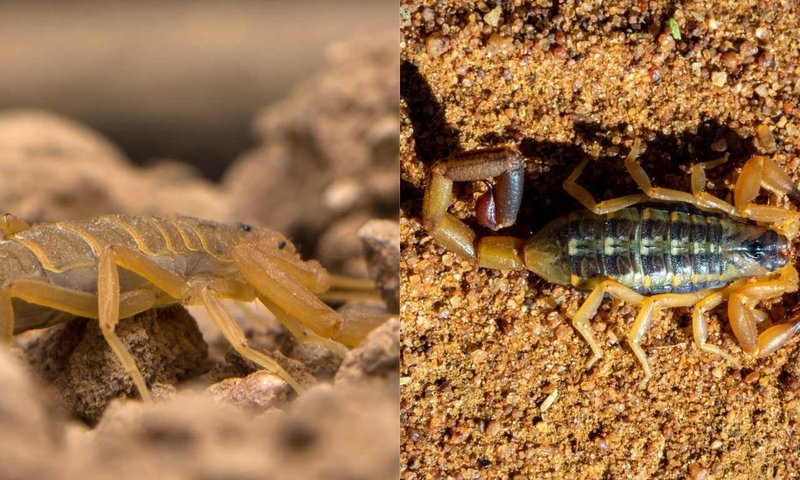
Imagine sitting at a café, sipping your coffee, and chatting about these little eight-legged wonders. You might start to wonder: What makes the striped bark scorpion different from other species? Maybe you’ve heard wild stories, or perhaps you’re just curious about their behavior, habitat, or the way they deal with threats. Let me walk you through the key differences and help you appreciate these critters a bit more.
What is the Striped Bark Scorpion?
The striped bark scorpion, scientifically known as *Centruroides vittatus*, is a species found primarily in the United States. It’s easily recognized by the distinct stripes running down its back, which act as natural camouflage against the bark of trees. These scorpions are usually small, measuring about 2.5 to 4 inches long. You might find them hiding in woody debris or beneath rocks in wooded areas and gardens.
One of the interesting things about the striped bark scorpion is its behavior. They are primarily nocturnal, which means they come alive at night, wanding around in search of prey—usually insects. During the day, they seek shelter in crevices, making them masters of concealment. This contrast between day and night activities adds an exciting layer to understanding their habits.
Comparing Physical Features
When it comes to physical appearances, the striped bark scorpion doesn’t look much like its relatives. For instance, unlike the Arizona bark scorpion (which is a bit larger and has a more slender build), the striped bark has a chunkier body. The striped patterns help it blend into its natural environment, while other scorpion species, like the Emperor scorpion, exhibit a glossy black appearance.
Here’s a quick rundown of the physical differences:
- The striped bark scorpion has noticeable stripes along its back, while many other species are solid-colored.
- It’s relatively small compared to species like the Emperor scorpion, which can grow to be up to 8 inches long.
- The pincers of the striped bark are less massive compared to the robust pincers of other scorpions, contributing to differences in hunting techniques.
These variations not only help with identification but also influence their hunting strategies and habitats.
Habitat Preferences
Habitat plays a significant role in distinguishing the striped bark scorpion from its cousins. You’ll often find these scorpions in more humid environments, like forests and gardens, where there’s plenty of shelter and food. In contrast, other species, like the desert-dwelling fat-tailed scorpion, thrive in arid, hot areas, where they can easily burrow in the sand.
The striped bark scorpion loves warmth and moisture, which is why it’s prevalent in eastern and central United States. They often like to hide under rocks, tree bark, or even within homes, taking advantage of the cool, dark spots. Understanding their habitat preferences helps in knowing where to find them and what other species might share the same space.
Behavioral Differences
The behaviors of the striped bark scorpion can differ significantly from other species. For example, these little guys are known for their unique communication methods. They often engage in elaborate courtship dances before mating, which is quite different from the more straightforward mating behaviors seen in other species, like the Scorpionidae family.
You might be wondering how they defend themselves. The striped bark scorpion tends to rely on its camouflage to stay hidden rather than aggressive behavior. If threatened, it will often curl up or scurry away to avoid confrontation. In contrast, other species, such as the Chinese red-headed scorpion, can be more aggressive and readily use their stings to fend off predators.
Here’s what to remember about their behaviors:
- Striped bark scorpions prefer to hide rather than fight.
- They exhibit unique courtship rituals compared to other species.
- They are primarily nocturnal, differing from some species that are more active during the day.
Venom Differences
Let’s talk about venom because, let’s face it, that’s what most people want to know about scorpions. The striped bark scorpion has venom that’s relatively mild compared to other species like the Arizona bark scorpion, which is considered one of the most venomous in North America.
The venom of the striped bark may cause localized pain, tingling, or mild swelling, but it’s rarely life-threatening. This makes them much less dangerous than their more toxic relatives. In fact, many people in areas where they’re common simply try to avoid them rather than worry about getting stung.
To break it down:
- The striped bark scorpion’s venom is mild and generally poses little risk to humans.
- In comparison, species like the Arizona bark scorpion have venom that can cause serious health issues.
- Most stings from striped bark scorpions can be treated with basic first aid.
This variance in venom potency highlights the importance of understanding each species’ characteristics—especially if you encounter them in the wild.
Where to Find the Striped Bark Scorpion
If you’re curious about where to find the striped bark scorpion, you’re in luck. They’re quite widespread in the United States! You’ll often spot them in gardens, under rocks, and among the wood piles. Their preference for warm, moist habitats makes them common in areas like Texas and the southeastern states.
Special care should be taken in places where humans live, especially during warmer months when they venture into homes in search of food or shelter. This can be a surprise for many homeowners! If you spot one, just remember to admire its unique beauty from a distance.
In contrast, many other species are more specialized in their habitats. For example, the Hadrurus arizonensis, known as the Arizona hairy scorpion, prefers the dry desert regions.
Conservation and Human Interactions
Lastly, let’s touch on how humans interact with striped bark scorpions. Many people fear them, often resulting in unnecessary kills when they encounter these creatures. With proper understanding and respect for their role in the ecosystem, we can minimize negative interactions.
These scorpions help control insect populations, which benefits agriculture and gardens alike. Educating ourselves about these creatures and their importance can help foster respect rather than fear.
Conversely, some other species face severe threats due to habitat loss and climate change. The efforts to conserve scorpion habitats can directly impact their populations and overall biodiversity.
In summary, understanding the differences between the striped bark scorpion and other species not only satisfies our curiosity but also highlights the beauty of biodiversity. So next time you see one of these critters scuttle by, remember the fascinating world they belong to and the unique traits that set them apart.
In the grand dance of nature, every species plays a role—it’s just a matter of looking a little closer to appreciate the details.

